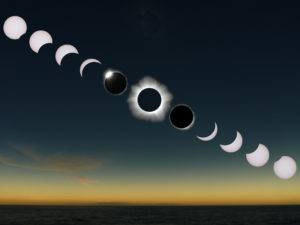
The total solar eclipse of Nov. 14, 2012, as seen from aboard the cruise ship Paul Gauguin in the South Pacific near New Caledonia. Photo by: Rick Fienberg / TravelQuest International / Wilderness Travel.
There are four types of solar eclipses – partial, annular, total and hybrid:
• The outer shadow cast by the moon, also called the penumbra, shows a partial eclipse.
• Annular eclipses occur when the moon doesn’t cover the sun entirely, leaving a “ring of fire” around the moon.
• The rare celestial phenomenon that is a total solar eclipse occurs as the orbital paths of the earth and the moon align perfectly with the position of the sun in our sky. Jackson County falls within the path of the umbra, or the inner shadow cast by the moon, where the sun is totally eclipsed.
• Hybrid solar eclipses change from an annular eclipse to a total eclipse along its path.
During a total eclipse, as the moon obscures the sun’s surface and darkens the sky, the sun’s atmosphere or corona is still visible. The sky won’t blacken instantly – the whole process is expected to take about three hours as the moon slowly moves in front of the sun.
The sky will begin darkening at 1:06 p.m. and will continue getting darker until totality hits at 2:35 p.m. Then, the process takes place in reverse.
Although the sun is about 400 times larger in diameter than the moon, the moon is also about 400 times closer to Earth than the sun. This ratio is ideal for making the sun and the moon appear to be the same size in our sky. The ratio constantly changes as the moon gradually moves away from the Earth, due to tide friction.
Billions of years ago, when the moon was much closer to the Earth than it is today, total eclipses occurred more often, but the sun’s corona was not as visible.
In the distant future, as the space between the earth and the moon increases by about an inch each year, the moon will appear smaller in our sky and become unable to totally eclipse the sun’s surface. At that point, only annular eclipses will be possible.
Essentially, the Earth is temporarily occupying a celestial sweet spot for viewing an eclipse.
For more information about solar eclipses, visit the Great American Eclipse website.
Related stories:



